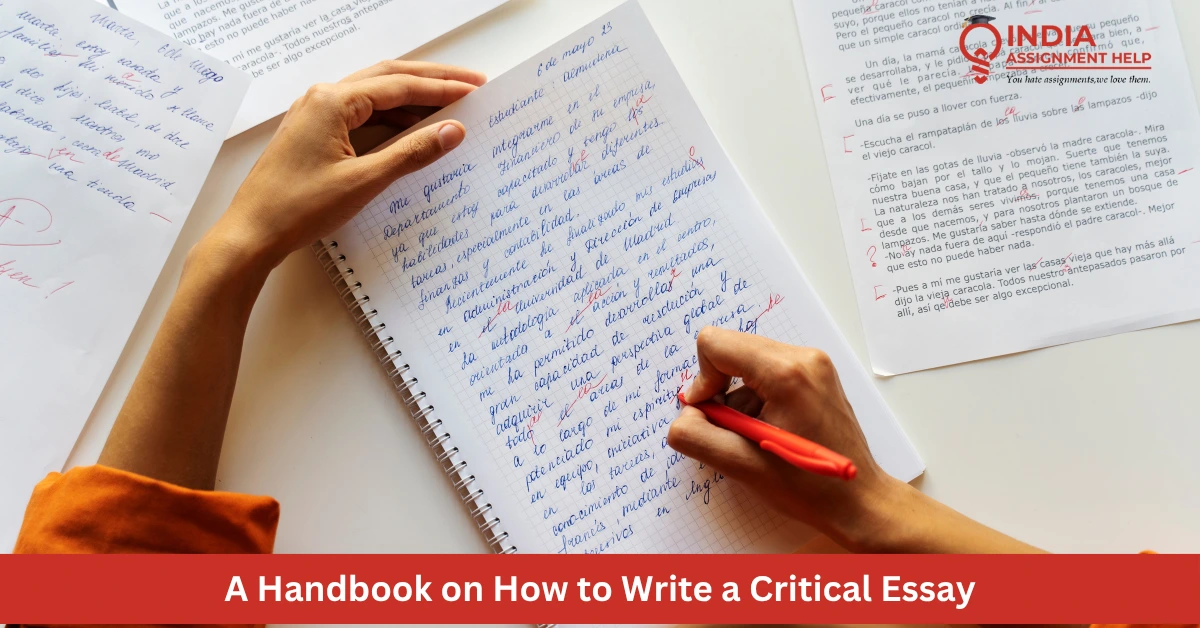A Handbook on How to Write a Critical Essay

How many times have you called a friend after watching a movie, just to tell them that you wasted your money on tickets? And then, what would your reaction be if your teacher asked you to write a critical essay on the same movie? You’d probably be thinking, "Wait, what am I supposed to write about?! I already know what happened!" Well, your professor doesn’t. When he asks you to write an essay, he wants to know what happened, how it happened, why it matters, and how it made you (viewers) feel. Let’s understand what a critical essay is and how to write one in detail.
What is a Critical Essay?
A critical essay is a form of academic writing that analyzes and evaluates a book, artwork, film, or text. For a student like you, it involves engaging with a text to understand the author’s idea and the meaning behind the text. It’s very different from a summary that just tells you what happened. A critical essay examines how and why something works, what it means, and whether it succeeds in its goals. You're not just describing the text; you're making an argument about the deeper significance of your subject.
Step 1: Choose and Understand Your Topic
Start by carefully reading or experiencing your subject multiple times. If it’s a novel, then you need to read it multiple times until you understand what is happening. Note down things like
- Initial reactions and emotions
- Confusing or striking moments
- Patterns you notice (themes, symbols, techniques)
- Questions that arise
If you're choosing a topic of your own, pick something that genuinely interests you and has enough complexity to analyse. A good critical essay topic should have multiple layers of meaning that are worth exploring. You can take help from essay writing services Singapore to understand your topic better.
Step 2: Develop Your Critical Lens
Before writing your critical essay, you’ve to decide what angle or perspective you'll take in your analysis. This is your critical approach or lens. Common approaches include:
- Literary analysis: Examining themes, symbolism, character development, or narrative techniques
- Historical context: How the work reflects or responds to its time period
- Social criticism: What the work says about society, class, gender, race, or power
- Formal analysis: How artistic techniques (style, structure, cinematography) create meaning
- Comparative analysis: How your subject relates to other works or ideas
You have to choose one primary lens to maintain focus.
Step 3: Formulate Your Thesis Statement
Your thesis is the central argument of your essay. It’s the main claim you'll prove through your analysis. A strong thesis should be:
- Specific: Avoid vague statements like "This book is interesting."
- Arguable: Someone could reasonably disagree with your interpretation
- Focused: Narrow enough to cover thoroughly in your word limit
- Analytical: Goes beyond obvious observations to reveal deeper meaning
Example of a weak thesis: "Shakespeare's Hamlet is about revenge."
Example of a strong thesis: "Through Hamlet's delayed revenge, Shakespeare demonstrates how overthinking can paralyse action and ultimately destroy both the thinker and those around him."
You can seek help from cheap essay writing services for developing a strong thesis statement.
Step 4: Gather and Organise Your Evidence
Now, it’s time to go back through your subject and collect specific evidence that supports your thesis. This includes:
- Direct quotes (for texts)
- Specific scenes or moments (for films/plays)
- Visual elements (for artwork)
- Concrete examples rather than generalisations
After this, you have to organize your evidence into 3-4 main supporting points. Each point should be different but also work together to prove your overall argument. You can also create a rough outline to show how these points build logically toward your conclusion. Many cheap essay writing services can help with this.
Step 5: Write Your Introduction
Your introduction should accomplish three things in this order:
- Hook the reader with an interesting opening that connects to your topic
- Provide necessary context about your subject (title, author, brief relevant background)
- Present your thesis statement clearly, usually as the last sentence
Remember to keep your introduction concise, about 10% of your total word count. Avoid starting with overly broad statements like "Throughout history, humans have always..."
Step 6: Develop Your Body Paragraphs
Each body paragraph should focus on one main supporting point. You can follow this structure:
Topic Sentence: State the main idea of the paragraph and how it supports your thesis.
Evidence: Introduce your specific example, quote, or scene. Integrate the quotes you’re using smoothly into your sentences rather than dropping them in awkwardly.
Analysis: This is the most important part. Here, you have to explain how your evidence proves your point. What techniques does the author use? What effect do they create? Why is this significant? Don't just describe what happened, but also analyze what it means and how it works.
Connection: Link back to your thesis and transition to your next point.
When you’re writing, aim for roughly equal paragraph lengths and ensure each paragraph advances your argument in a new way. Essay writing services Singapore have literature experts who can help you with organizing your body paragraphs.
Step 7: Address Counterarguments
This is optional but effective. In lengthy essays, you also have to acknowledge potential counterarguments or alternative interpretations. This shows sophisticated thinking and strengthens your position. Briefly present the opposing view, then explain why your interpretation is more convincing or complete.
Step 8: Write Your Conclusion
Your conclusion should:
- Restate your thesis in fresh language (don't just copy and paste)
- Synthesise your main points to show how they work together
- Discuss broader significance of your argument—why does your interpretation matter?
Avoid introducing completely new ideas or ending with generic statements like "In conclusion, this essay has shown..."
Step 9: Revise and Polish
Good critical essays are rewritten, not just written. During revision:
Check Your Argument: Does each paragraph support your thesis? Are there logical gaps or contradictions?
Strengthen Your Analysis: Have you moved beyond summary to interpretation? Is your analysis specific and detailed?
Improve Flow: Do paragraphs connect smoothly? Are transitions clear?
Refine Your Language: Eliminate unnecessary words, vary sentence structure, and ensure your tone is appropriate for academic writing.
Step 10: Proofread and Format
Finally, carefully proofread for:
- Grammar and spelling errors
- Proper citation format (MLA, APA, etc.)
- Consistent formatting
- Accurate quotes and references
Read your essay aloud to catch awkward phrasing or missing words.
Common Pitfalls to Avoid
- Plot summary instead of analysis: Don't retell what happens; analyse what it means
- Unsupported claims: Every argument needs specific evidence
- Obvious observations: Push beyond surface-level interpretations
- Personal opinion without justification: Your feelings matter less than your reasoned analysis
- Trying to cover too much: It's Better to analyse fewer points thoroughly than many points superficially
Final Tips for Success
Don’t get stressed if you don’t get it right the first time. Critical writing is a skill that improves with practice, and that’s why you have to start early to allow time for multiple drafts. You can read examples of strong critical essays in your field to see how experienced writers structure their arguments and present their analysis.
Most importantly, trust your insights. If you notice something interesting or a point that makes you curious, note it down because it could be the beginning of a strong critical argument. The best critical essays combine careful observation with thoughtful interpretation to reveal new ways of understanding familiar works.
Your goal is not to find the "right" answer; it's to make a convincing case for your interpretation using evidence and logical reasoning. When you succeed, you'll help your readers see your subject in a new and meaningful way.
We hope this guide helped answer all your questions. If you’re still left with any other queries, feel free to reach out to India Assignment Help to get help from top essay writing experts in Singapore.





